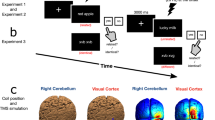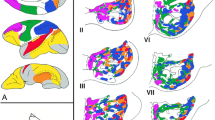Abstract
Positron emission tomography (PET) was used to examine the neural substrate underlying self-initiated versus externally triggered synchronized movements. Seven healthy subjects performed synchronized right index finger and foot movements in two conditions: either by setting them going at their own pace (self-initiated condition) or by reacting to randomly dispensed auditory signals (externally triggered condition). In addition, subjects either self-initiated or performed in reaction to an audible tone a sequence of finger and foot movements. We hypothesized that cerebellar activity would reflect the behavioural difference observed when hand and foot are self-initiated synchronously compared to when these movements are externally triggered. Consistent with early observations by one of us (Paillard 1948, Année Psychologique, pp 28–47), subjects exhibited a precession of finger initiation over foot dorsi-flexion in the externally triggered condition, and a precession of foot dorsi-flexion over finger onset in the self-initiated condition. In addition to the cortical areas already described in the literature as differently activated in self-initiated and externally triggered movements, we found, according to the research hypothesis, a prominent activation of the left postero-lateral hemi-cerebellum in self-initiated synchronized movements when compared to the externally triggered movements. No cerebellar activity was found for self-initiated sequence of hand-foot movements when compared to externally triggered sequence of hand and foot movements. We suggest that this cerebellar activity could be related to some motor timing processes specifically required by the self-initiated synchronized movements.


Similar content being viewed by others
References
Bard C, Paillard J, Lajoie Y, Fleury M, Teasdale N, Forget R, Lamarre Y (1992) Role of afferent information in the timing motor commands: a comparative study with a deafferented patient. Neuropsychologia 30:201–206
Deiber MP, Honda M, Ibanez V, Sadato N, Hallett M (1999) Mesial motor areas in self-initiated versus externally triggered movements examined with fMRI: Effect of movement type and rate. J Neurophysiol 81:3065–3077
Evans AC, Marrett S, Torrescorzo J, Ku S, Collins L (1991) MRI-PET correlation in three dimensions using a volume-of-interest (VOI) atlas. J Cereb Blood Flow Metab 11: A69–A78
Evans AC, Marrett S, Neelin P, Collins L, Worsley K, Dai W, Milot S, Meyer E, Bub D (1992) Anatomical mapping of functional activation in stereotactic coordinate space Neuroimage 1:43–63
Fox PT, Raichle ME (1984) Stimulus rate dependence of regional cerebral blood flow in human striate cortex, demonstrated by positron emission tomography. J Neurophysiol 51:1109–1120
Fox PT, Perlmutter JS, Raichle ME (1985) A stereotactic method of anatomical localization for positron emission tomography. J Comput Assist Tomogr 9:141–153
Goldberg G (1985) Supplementary motor area structure and function: review and hypothesis. Behav Brain Sci 8:567–616
Ivry R (1997) Cerebellar timing systems. In: Schmahmann JD (ed) The cerebellum and cognition. Academic Press, Boston, pp 555–573
Ivry R, Keele S, Diener H (1988) Dissociation of the lateral and medial cerebellum in movement timing and movement execution. Exp Brain Res 73:167–180
Janhanshahi M, Jenkins H, Brown RG, Marsden D, Passingham RE, Brooks DJ (1995) Self-initiated versus externally triggered movements I. An investigation using measurement of regional cerebral blood flow with PET and movement-related potentials in normal and Parkinson’s disease subjects. Brain 118:913–933
Jenkins IH, Jahanshahi M, Juepter M, Passingham RE, Brooks DJ (2000) Self-initiated versus externally triggered movements II. The effect of movement predictability on regional cerebral blood flow. Brain 123:1216–1228
Jueptner M, Flerich L, Weiller C, Mueller SP, Diener HC (1996) The human cerebellum and temporal information processing-results from a PET experiment. Neuroreport 7:2761–2765
Larsson J, Guylyas B, Roland PE (1996) Cortical representation of self-paced finger movement. Neuroreport 7:463–468
Mushiake H, Inase M, Tanji J (1991) Neuronal activity in the primate premotor, supplementary, and precentral motor cortex during visually guided and internally determined sequential movements. J Neurophysiol 66:705–718
Owen AM, Doyon J, Dagher A, Sadikot A, Evans AC (1998) Abnormal basal ganglia outflow in Parkinson’s disease identified with PET. Implications for higher cortical functions. Brain 121:949–965
Paillard J (1948) Quelques données psychophysiologiques relatives au déclenchement de la commande motrice. Année Psychologique pp 28–47
Paillard J (1990) Réactif et prédictif: deux modes de gestion du geste de la motricité. In: Nougier V, Blanchi JP (eds) Pratiques sportives et modélisation du geste. Université Joseph-Fourier, Grenoble, pp 13–56
Picard N, Strick PL (1996) Motor areas of the medial wall: a review of their location and functional activation. Cereb Cortex 6:342–353
Raichle ME, Martin WR, Herscovitch P, Mintun MA, Markham J (1983) Brain blood flow measured with intravenous H2 15O. II. Implementation and validation. J Nucl Med 24: 790–798
Schmahmann JD, Doyon J, Toga AW, Petrides M, Evans AC (2000) MRI atlas of the human cerebellum. Academic Press, San Diego
Talairach J, Tournoux P (1988) Co-Planar stereotaxic atlas of the human brain: an approach to cerebral imaging. Georg Thieme Verlag, New York
Thaler DE, Rolls ET, Passingham RE (1988) Neuronal activity of the supplementary motor area (SMA) during internally and externally triggered wrist movements. Neurosci Lett 93:264–269
Thut G, Hauert CA, Viviani P, Morand S, Spinelli L, Blanke O, Landis T, Michel C (2000) Internally driven vs externally cued movement selection: a study on the timing of brain activity. Cogn Brain Res 9:261–269
Weeks RA, Honda M, Catalan MJ, Hallett M (2001) Comparison of auditory, somatosensory and visually instructed and internally generated finger movements: a PET study. Neuroimage 14:219–230
Wessel K, Zeffiro T, Toro C, Hallett M (1997) Self-paced versus metronome-paced finger movements. J Neuroimaging 7:145–151
Worsley KJ, Evans AC, Marrett S, Neelin P (1992) Determining the number of statistically significant areas of activation in subtracted activation studies from PET. J Cereb Blood Flow Metab 12:900–918
Worsley KJ, Marrett S, Neelin P, Vandal AC, Friston KJ, Evans AC (1996) A unified statistical approach for determining significant signals in images of cerebral activation. Hum Brain Map 4:58–73
Acknowledgements
We wish to thank the subjects who participated in this study. Thanks also go to Dr. Julien Doyon for his help to design the experiment and to analyse the data and to the staff of the McConnell Brain Imaging Centre and of the Medical Cyclotron Unit for their assistance in the collection and analysis of these data. The financial support by NSERC (National Sciences and Engineering Reseach Council of Canada) and CIHR-FCQ (Canadian Institutes of Health Research-Fondation Chiropratique du Québec) is gratefully acknowledged.
Author information
Authors and Affiliations
Corresponding author
Rights and permissions
About this article
Cite this article
Blouin, JS., Bard, C. & Paillard, J. Contribution of the cerebellum to self-initiated synchronized movements: a PET study. Exp Brain Res 155, 63–68 (2004). https://doi.org/10.1007/s00221-003-1709-9
Received:
Accepted:
Published:
Issue Date:
DOI: https://doi.org/10.1007/s00221-003-1709-9




